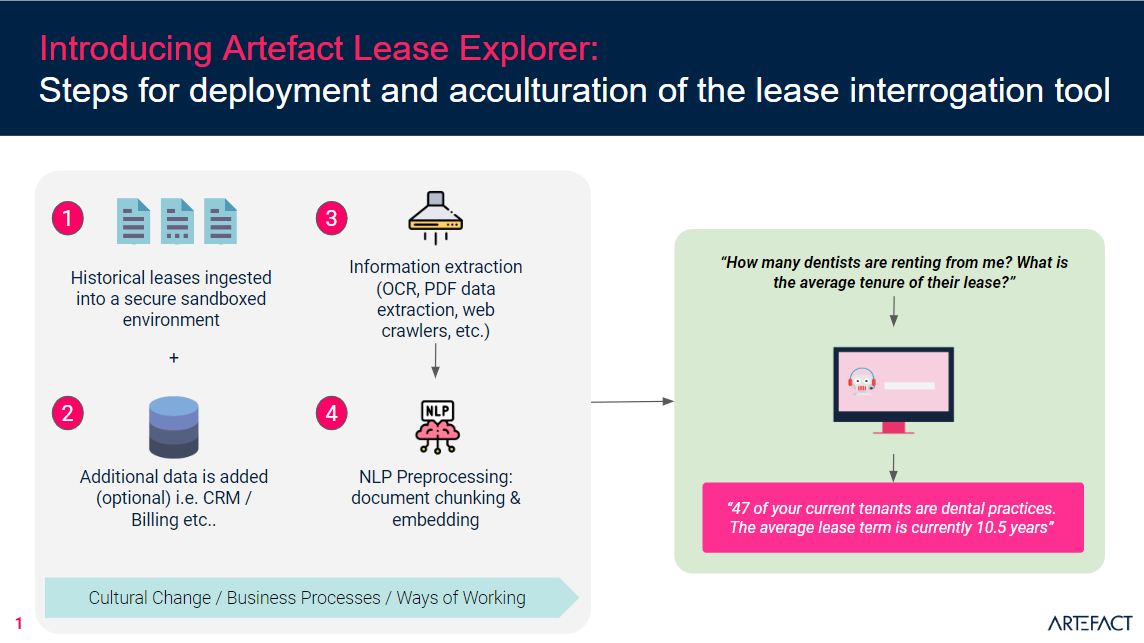With today’s advances in AI technology, what was complex and tedious can now be done quickly and efficiently. One of these examples can be found in historical lease interrogation. With a custom generative AI solution, a secure sandboxed environment can be created in which all historical real estate leases are uploaded.
This will enable any user within the firm to access a chatbot to ask it natural language questions about any aspects of the leases. This in essence becomes a dynamic lease management tool which delivers incredible instantaneous insights at the fingertips of all users.
What’s the problem
Today, most landlords have to juggle with vast amounts of historical leases. These are generally summarised in vast and complex spreadsheets or occasionally in dedicated lease management software. Existing solutions are static, rigid and inefficient which can create frustration. They are also not sufficiently flexible and only provide some insights with limited functionality. Any question outside of the prescribed KPIs requires manual reading of (often hundreds if not thousands of) leases. Significant time is spent by the insights team to generate presentations of portfolios and leases, depriving executives from time-sensitive insights which would aid decision making.
What’s the solution
Directly addressing the bugbears of real estate executives, Artefact has developed its proprietary Lease Explorer tool. This is a purpose-built and custom tool that allows for the rapid deployment of powerful Large Language Models (LLMs) within a sandboxed, proprietary environment containing historical property leases. Real estate executives are then able to interrogate their own historical leases directly with the use of a ChatGPT-like interface.
The Lease Explorer consists of five broad steps:
Needless to say, adoption of such a tool as above would require a period of underlying change management as new business processes and ways of working would need to be adopted.

What kind of natural language questions could be answered
With the implementation of Lease Explorer, we posit some natural language prompts that a real estate executive might be able to ask the tool’s ChatBot. Of course, the extent to which the tool can accurately return a response to the below non-exhaustive question list is conditional upon the quality, structure and availability of input data, which may require access to information beyond that simply contained in a lease document.
What benefits does this generate
The adoption of an AI tool like Enterprise ChatGPT will accrue a range of benefits to real estate professionals. On the first hand, the tool is likely to provide a sea change with regard to the speed at which insights are able to be obtained, thereby greatly empowering decision-makers with rapid access to critical information. Furthermore, the scalability and adaptability of such a tool to ingest an ever-growing volume of lease data would be invaluable to assist the future-proofing of a real estate business to the increasing demands of the industry.
Adoption of such a tool is likely to yield a step change internally within a real estate organisation too. The adoption of an AI tool will minimise any reliance on previously manual processes with respect to interrogating leases. Rather than relying on the incorruptibility of a spreadsheet and continuing service of key admin personnel, an AI tool would be able to take on board the questions in natural language of executives directly and provide accurate responses in a timely fashion. Essentially, overreliance on key dependencies for data search and retrieval is reduced and there is scope for executives to reduce resources required in the insight generation process. Further, in order to get the best value from such an AI tool, adoption is likely to require a business to undergo a transformative data hygiene process, thereby elevating the internal thresholds of data management as the insights generated can only ever be as good as the information collated.
GenAI additionally has certain benefits for such a tool over traditional AI / ML solutions. Traditionally, vast amounts of labelled data were required to train and evaluate a model for a specific task. This is no longer required thanks to generative AI, speeding up the development of such solutions. Further, generative AI allows solutions to evolve and change without massive additional re-work and development – solutions can be more flexible and less rigid.
How is accuracy established
Implementing a novel AI tool for the first time and enabling it to generate powerful executive insights with a mere prompt can no doubt be daunting, especially given GenAI’s well-cited drawback of “hallucinations”. The following steps when taken in concert should provide sufficient guardrailing to ensure the best value can be extracted from the tool.
What limitations exist
For this solution to work as desired, there are a number of considerations to take into account. Firstly, the model would most likely be limited to UK leases, due to the property sector’s peculiarities around location and its legislations. The Lease Explorer would have no predictive capabilities, as only historical performance from existing documents would be interrogated.
Additionally, like any GenAI based tool, the Lease Explorer would struggle with unclear and vague user prompts, which might not yield the desired results. As such, it is always recommended to formulate questions to the chat interface properly, similarly akin to how one might ask a question to an analyst within their real estate team.
It is important to note that the reading and processing of PDF documents into machine-readable format requires OCR (optical character recognition) as a necessary step in the ingestion process. Documents that are not machine readable or that have a complex page format and structure might not be ingested correctly and downstream this is likely to affect tasks such as extracting information and providing reliable answers.
Furthermore, to answer analytical quantitative questions, further processes are required:
Costs and requirements
The deployment and acculturation of Artefact’s Lease Explorer tool would reasonably cost from c.£45 k and would require at least four weeks of working cooperatively depending on chosen functionalities. This would of course be under the assumption that uploaded leases are all machine readable, substantially similar and in English. Following deployment of Lease Explorer, an ongoing subscription would be required to any GenAI LLM that is used to build the custom tool.
Why Artefact?
Artefact is a leading global consulting company dedicated to accelerating the adoption of data and AI to positively impact people and organisations. We specialise in data transformation and data marketing to drive tangible business results across the entire enterprise value chain. Artefact offers the most comprehensive set of data-driven solutions, built on deep data science and cutting-edge AI technologies, delivering AI projects at scale across the property sector in the UK.
We are trusted partners to property businesses across residential, commercial, industrial and specialist asset classes. Our partners include FTSE 350 listed companies and similar-sized private organisations. With over 20 years of experience in real estate, our dedicated property team includes experts and chartered professionals in property valuations, urban planning, development, and financing.
Our previous work ranges from developing data-led dynamic strategies with our clients – informing them where to play and how to win in their chosen markets – to major operational changes, such as establishing new business arms and propositions. We have worked in every stage of the property lifecycle, from land acquisition to ongoing maintenance, and have worked with clients to scientifically improve these processes.

Interested in Data Consulting | Data & Digital Marketing | Digital Commerce ?
Read our monthly newsletter to get actionable advice, insights, business cases, from all our data experts around the world!
 BLOG
BLOG




